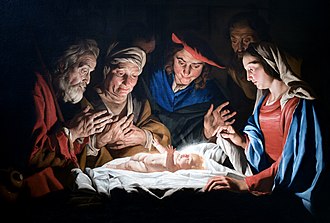
Back Weihnachtsgeschichte ALS ميلاد يسوع Arabic İsanın doğulması Azerbaijani Kamundagan ni Jesus BCL Karanakan Yesus BJN যিশুর জন্ম Bengali/Bangla Ginivelezh Breton Nativitat de Jesús Catalan Ježíšovo narození Czech Geni'r Iesu Welsh

| Part of a series on |
 |
The Nativity or birth of Jesus Christ is documented in the biblical gospels of Luke and Matthew. The two accounts agree that Jesus was born in Bethlehem, in Roman-controlled Judea, that his mother, Mary, was engaged to a man named Joseph, who was descended from King David and was not his biological father, and that his birth was caused by divine intervention. Some scholars do not see the two canonical gospel Nativity stories as historically factual[1][2] since they present clashing accounts and irreconcilable genealogies. The secular history of the time does not synchronize with the narratives of the birth and early childhood of Jesus in the two gospels.[3][4][5] Some view the question of historicity as secondary, given that gospels were primarily written as theological documents rather than chronological timelines.
The Nativity is the basis for the Christian holiday of Christmas and plays a major role in the Christian liturgical year. Many Christians traditionally display small manger scenes depicting the Nativity within or outside of their homes, or attend Nativity plays or Christmas pageants focusing on the Nativity cycle in the Bible. Elaborate Nativity displays featuring life-sized statues are a tradition in many continental European countries during the Christmas season.
The artistic depiction of the Nativity has been an important subject for Christian artists since the 4th century. Artistic depictions of the Nativity scene since the 13th century have emphasized the humility of Jesus and promoted a more tender image of him, a major change from the early "Lord and Master" image, mirroring changes in the common approaches taken by Christian pastoral ministry during the same era.
- ^ Cite error: The named reference
Sanders birthwas invoked but never defined (see the help page). - ^ Marcus Borg, 'The Meaning of the Birth Stories' in Marcus Borg, N T Wright, The Meaning of Jesus: Two Visions (Harper One, 1999) page 179: "I (and most mainline scholars) do not see these stories as historically factual."
- ^ Crossan, John Dominic; Watts, Richard J. (October 1999). Who Is Jesus?: Answers to Your Questions About the Historical Jesus. Louisville, Ky.: Westminster John Knox Press. pp. 11–12. ISBN 978-0-664-25842-9.
- ^ Cite error: The named reference
Vermes 64was invoked but never defined (see the help page). - ^ Encyclopedia of theology: a concise Sacramentum mundi by Karl Rahner 2004 ISBN 0-86012-006-6 p. 731